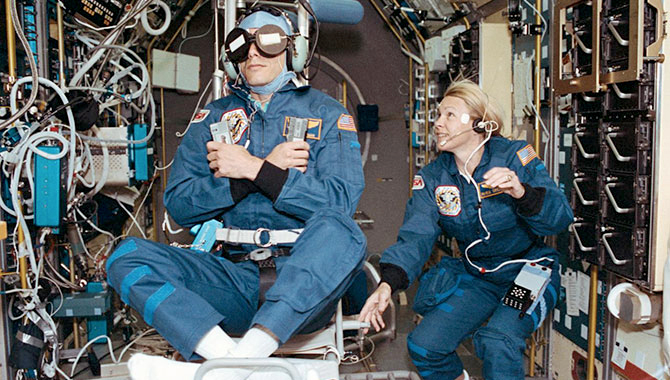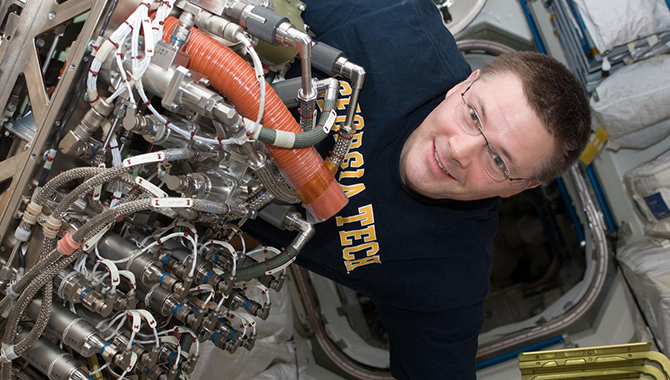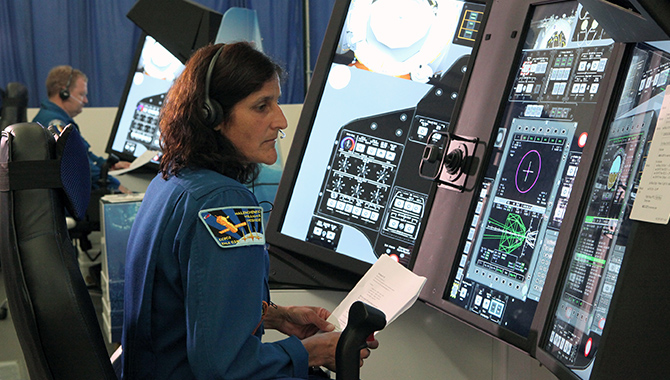
NASA Astronaut Kjell Lindgren corrals the supply of fresh fruit that arrived at the International Space Station in August 2015.
Photo Credit: NASA
Astronaut Kjell Lindgren provided a crew member’s perspective of human spaceflight lessons learned during a recent knowledge sharing forum.
Editor’s Note: NASA’s Office of the Chief Engineer and the Human Exploration and Operations Mission Directorate sponsored the Human Spaceflight Knowledge Sharing Forum in November 2016. Select individuals responsible for shaping NASA’s future over the next 10 to 20 years focused on technical best practices and lessons learned from successful and unsuccessful human spaceflight missions. This is part of a series of articles recapping lessons learned and knowledge shared by these individuals at the pilot knowledge sharing event.
Lindgren began by expressing appreciation to the Chief Medical Officer and forum attendees for their advocacy for the crew and their work to make sure missions are safe and successful. He emphasized the importance of incorporating human factors and concerns early on in the design of procedures, software and equipment. “As we think about future vehicles and future missions, just own the onboard perspective. Utilize the human factors, folks,” he said during his forum presentation. “It pays absolute dividends in the end so that we don’t have to do the workarounds.”
NASA Astronaut Kjell Lindgren.Photo Credit: NASA
Lindgren’s “Crew Office Lessons Learned” presentation at the forum included snapshots of his own human spaceflight experience. He flew on Expedition 44/45, logged 141 days in space, and participated in two spacewalks and more than 100 different scientific experiments. Lindgren was selected as an astronaut in 2009 as one of 14 members of the 20th NASA astronaut class. He holds a Doctorate of Medicine from the University of Colorado and is board certified in emergency and aerospace medicine.
He says it’s “absolutely amazing” to work in the challenging space environment. “That work is critically important,” he said. “We feel like we are doing work that is important to our future in the solar system and to the lives back here on Earth. And having meaningful work is critically important.”
He said the International Space Station (ISS) is a great place for long-duration crews to live and work. “The truth of the matter is that we’re at the 90 to 95 percent solution on the space station now for many things. We’ve been doing this for 16 years,” said Lindgren. “But it is still like going camping.” He cited examples such as the lack of a dedicated hygiene area and not having a variety of food.
Balanced Training
One of the lessons learned is that balanced training is important. Crew training for a six-month mission is a one-and-a-half to two-year process, and some details trained on the ground are lost months later when the activity is performed on orbit. Lindgren said most crew members think training could be more efficient. Specifically, he noted that significant time is spent on topics not used on-orbit and that classroom PowerPoint presentations are the hardest to recall. He said robotic simulations, training in the Neutral Buoyancy Laboratory, and other activities that build muscle memory skills are more easily recalled. He said emergency response and critical ops training is important, and that the crew also must maintain a high level of proficiency in ISS systems and maintenance, extravehicular activity, robotics, and Soyuz systems and flight procedures (in Russian).
“I think one of the biggest surprises for me when I got to the space station — and this was a pleasant surprise — is that there is nothing that I was asked to do that I did not feel competent or prepared for,” said Lindgren. “That speaks to a terrific training process, probably a little bit of over-training. But it meant that we were checking all of the boxes, and that’s a good place to be.”
The Johnson Space Center Flight Operations Directorate, which is responsible for providing trained astronaut crew members for NASA human spaceflight programs, is working toward day-in-the-life type training and routine operations training. Lindgren said short videos that offer a brief overview of simpler procedures are very effective on ISS.
| Related Video: Kjell Lindgren’s Human Spaceflight Knowledge Sharing Forum presentation on Crew Office Lessons Learned |
Minimizing Mistakes
Lindgren noted that since the human spaceflight equation includes humans, mistakes will happen on the ground and on orbit, but said the key is learning from the mistakes, sharing lessons learned from mistakes, and avoiding repeat mistakes. In addition to training, he said good communication, teamwork and procedures are the main mechanisms the team uses to minimize the frequency, effect and severity of mistakes to keep from putting the crew or the spacecraft at risk.
Lindgren recalled a mistake he made while changing a cable on the Advanced Resistive Exercise Device (ARED) on ISS. After spending two hours installing the cable, Lindgren called to notify ground controllers the C-clamp wasn’t working according to procedure. He had mistakenly grabbed a left-sided cable for the right side of the device and was advised to uninstall it.
“That sounds like a pretty trivial and minor thing. And in the scope of things, it was. But from a crew perspective, man, I beat myself up over that for hours,” said Lindgren. “You’ve got to get to a point, like with all mistakes, that you say, ‘OK, I made a mistake. Now it’s time to fix it, and move on.’ But you recognize you’re living in this fishbowl. Everybody’s seeing you make this dumb mistake. And it’s important to be able to compartmentalize that stuff.”
Teamwork
Lindgren said crew teamwork – “that desire to help each other out” – as well as teamwork with the ground is absolutely critical to good performance on orbit. He said he was delighted with the relationship with the ground team. “We believed that the ground had our priorities in mind. We trusted them. And that all came from very good communication,” he said.
Crew members have a great relationship with their training teams as a result of spending many hours working together over the course of two years of training. “But with the ops team, we don’t work with them until we get on station. And now we have this 250-mile gap between us,” said Lindgren. “So, intentionally getting together before flight, getting to know the flight director and all the discipline leads is very important for on-orbit operations.”
The crew is able to communicate with the ground 80 to 90 percent of the time. Lindgren says the excellent communication capability enhances teamwork. “I think just adopting that posture of ‘Call anytime’ is super important,” said Lindgren. “There’s this idea of ‘Don’t bother the crew.’ But we want that feedback. We want to do a good job for the team.”
He said international partnerships are absolutely essential. “I think that the greatest benefit that this program has provided is that international piece,” said Lindgren. “The International Space Station is a testament to what our countries are able to accomplish when we work together. We have created something remarkable.”
Related Videos:
| Kjell Lindgren on the Importance of Human Factors | Kjell Lindgren on Astronaut Training |









